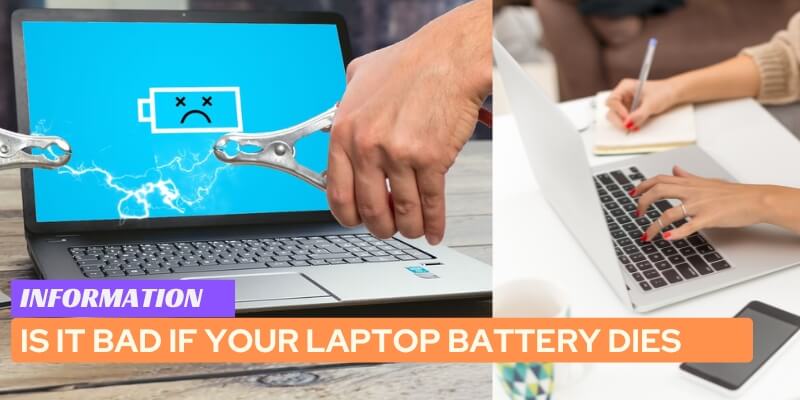Yes, it is bad if your laptop battery dies as it can cause data loss and disrupt your work. A dead laptop battery can be a major inconvenience, especially if you are in the middle of important tasks or projects.
Not only does it disrupt your workflow and cause potential data loss, but it also hampers your productivity until you can find an alternative power source or replace the battery.
Moreover, constantly draining your laptop battery and allowing it to die can shorten its lifespan and overall battery capacity.
This means that your laptop may not hold a charge for as long in the future, further reducing its usability.
We will explore the consequences of a dead laptop battery and provide some tips to help you avoid this situation.
Table of Contents
- The Impact Of A Dead Laptop Battery On Productivity
- The Physical Effects Of Laptop Battery Death
- The Psychological Impact Of A Dead Battery
- Background Applications And Processes
- Display And Brightness Settings
- Battery Age And Health
- Optimizing Power Saving Settings
- Closing Unnecessary Apps And Processes
- Managing External Devices And Connections
- Signs That A Laptop Battery Needs Replacement
- Proper Disposal And Recycling Of Laptop Batteries
The Impact Of A Dead Laptop Battery On Productivity
Having a dead laptop battery can significantly hamper your productivity and disrupt your work routine.
In this digital age, where remote work and flexible schedules have become the norm, a laptop that runs out of battery can leave you feeling frustrated and unproductive.
Let’s explore the various ways in which a dead laptop battery can impact your ability to work efficiently and affect your overall productivity.
1. Decreased ability to work remotely
With the advancement of technology, remote work has become increasingly popular. Many professionals now have the privilege of working from the comfort of their homes, coffee shops, or co-working spaces.
However, if your laptop battery dies while you’re away from a power source, your ability to work remotely is severely affected.
This can be particularly challenging if you have an important deadline to meet or if you’re in the middle of an important task.
When your laptop battery dies, you may find yourself scrambling to find an alternative power source or needing to rush back home, disrupting your workflow and causing unnecessary stress.
2. Interruptions and loss of progress
A dead laptop battery can result in sudden interruptions and loss of progress. Imagine you’re working on a project or writing a lengthy email, and suddenly your laptop shuts down due to a drained battery.
Not only does this interruption break your concentration but it can also lead to the loss of unsaved work.
Losing hours of work or having to start a task from scratch due to a dead battery can be demoralizing and significantly impact your productivity.
It’s crucial to have a fully charged battery to minimize such interruptions and safeguard your progress.
3. Delayed deadlines and missed opportunities
One of the most detrimental consequences of a dead laptop battery is the potential for delayed deadlines and missed opportunities.
Professional commitments, such as client meetings, conference calls, or webinars, may be missed if your laptop battery dies at the wrong time.
These missed opportunities can hinder your professional growth and impact your reputation.
Additionally, if you’re working on time-sensitive projects or collaborating with a remote team, a dead battery can lead to missed deadlines and negatively affect your work relationships.
It’s vital to keep your laptop battery charged and have a backup plan in place to prevent these setbacks from occurring.
A dead laptop battery can have a significant impact on your productivity. From decreased ability to work remotely to interruptions and loss of progress, as well as delayed deadlines and missed opportunities, the consequences of a dead battery can be detrimental.
To maintain productivity, ensure you have a fully charged battery, carry a charger, and consider investing in a spare battery or a power bank to avoid any unnecessary disruptions and maximize your efficiency.
The Physical Effects Of Laptop Battery Death
1. Potential damage to internal components
When your laptop battery dies, it can have serious physical effects on the internal components of your device.
The sudden loss of power can cause the laptop to shut down abruptly, which can lead to potential damage to these components.
The most vulnerable parts of the laptop include the hard drive, motherboard, and processor. These components are essential for the proper functioning of your laptop, and any damage to them can result in expensive repairs or even complete failure of the device.
2. Increased risk of data loss
One of the major concerns when your laptop battery dies is the increased risk of data loss. When your laptop loses power unexpectedly, any unsaved work or data that was being processed at the time can be lost.
This can be especially problematic if you were working on important documents, projects, or files that had not been backed up.
Additionally, if the sudden power loss causes damage to the hard drive, you may not be able to retrieve or access your data at all.
It’s crucial to regularly save and backup your files to minimize the risk of data loss in case of battery failure.
3. Reduced lifespan of the laptop
Another physical effect of laptop battery death is the reduced lifespan of the device itself. Over time, the constant cycling of the battery, from fully charged to depleted and back, can cause wear and tear.
If the battery dies frequently or remains discharged for extended periods, it can have a negative impact on the overall health of the battery.
This can lead to a shorter lifespan and the need for frequent battery replacements.
Moreover, when the laptop battery dies, it often relies solely on AC power, which can cause additional strain on the internal components.
This excess strain can result in increased heat generation and temperature, potentially leading to damage and decreased performance of the laptop in the long run.
It is important to prioritize the maintenance and health of your laptop’s battery to ensure its longevity and efficient function.
The Psychological Impact Of A Dead Battery
It’s happened to all of us – you’re in the middle of an important task on your laptop when suddenly, the battery dies.
Not only is this frustrating in a practical sense, but it can also have a significant psychological impact.
The sudden loss of power can lead to feelings of frustration, stress, and a negative impact on mental health.
In this section, we will explore the psychological effects of a dead battery and how it can impact our overall well-being.
1. Frustration and Stress
When your laptop battery dies, it’s natural to feel frustrated. You may be in the middle of an important project or task, and the sudden loss of power can disrupt your workflow and cause stress.
The frustration and stress can be amplified if you don't have access to a power source or if you're on the move.
It can feel like a roadblock in your productivity and can leave you feeling overwhelmed and anxious.
2. Loss of Confidence and Productivity
A dead laptop battery can also have a significant impact on your confidence and productivity.
If you rely heavily on your laptop for work or personal use, being forced to stop because of a dead battery can make you question your abilities and capabilities.
It can make you feel less productive and efficient, leading to a decrease in confidence. The interruption in your workflow can also make it harder to get back on track once your laptop is charged, further impacting your overall productivity.
3. Negative Effects on Mental Health
The psychological impact of a dead laptop battery can extend beyond frustration and stress. It can have negative effects on your mental health as well.
The interruption in your work or personal tasks can lead to feelings of guilt, self-doubt, and a sense of being unproductive.
Additionally, constant worry about your laptop battery life can create anxiety and cause you to constantly monitor your power levels, further impacting your mental well-being.
These negative effects on mental health can have long-term consequences if not addressed and managed properly.
Overall, the psychological impact of a dead laptop battery is more than just a minor inconvenience.
It can lead to frustration, stress, a loss of confidence and productivity, and even negative effects on mental health.
It’s important to recognize and address these psychological effects to maintain a healthy relationship with technology and ensure our overall well-being.
Background Applications And Processes
One of the factors that can significantly impact your laptop battery life is the presence of background applications and processes.
These are running in the background without your knowledge or active control, consuming precious energy and draining your battery life.
In this section, we will explore two key aspects related to background applications and processes: energy-consuming apps and software, and unnecessary background processes.
We will also delve into the role of antivirus software and its impact on your laptop’s battery performance.
1. Energy-consuming apps and software
Many modern applications and software are designed with various features and functionalities, which can be both a boon and a bane for your laptop’s battery life.
Some apps, by their very nature, require more energy to function optimally. For example, graphics-intensive programs, video-editing software, or high-demand games can put a significant strain on your battery, causing it to drain faster than usual.
It’s essential to identify these energy-consuming apps and be mindful of their usage, especially when you’re running your laptop on battery power.
Avoid running multiple power-hungry applications simultaneously, as this can put an unnecessary burden on your laptop’s battery.
Instead, prioritize the ones you really need and close or minimize the others. Likewise, be cautious with resource-intensive software that runs in the background, such as media players or file-sharing software.
While they may offer convenience and functionality, they can drain your laptop’s battery faster than you might expect.
2. Unnecessary background processes
In addition to energy-consuming apps and software, unnecessary background processes can also play a significant role in depleting your laptop’s battery.
These processes may be related to system updates, automatic backups, or even applications and services that activate themselves during startup.
To ensure optimal battery life, it’s crucial to keep an eye on these background processes and determine if they are essential.
Some processes can be disabled or configured to run less frequently, minimizing their impact on battery performance.
For example, you can adjust your system settings to prevent automatic updates when your laptop is running on battery power.
By controlling unnecessary background processes, you can prolong your laptop’s battery life and enjoy a longer untethered computing experience.
3. The role of antivirus software
Antivirus software is essential for safeguarding your laptop’s security and protecting it from malicious threats.
However, it’s worth noting that some antivirus programs can impact your laptop’s battery life.
These software often run continuous scans, monitor real-time activities, and perform frequent updates to keep your device protected.
While it’s important not to compromise your laptop’s security, you can customize your antivirus software settings to strike a balance between protection and battery life.
Some programs offer power-saving modes or options to adjust scan frequencies, allowing you to optimize the software’s impact on battery consumption.
It’s worth exploring these settings and finding the right balance according to your needs.
In summary, background applications and processes can significantly affect your laptop’s battery life.
Being mindful of energy-consuming apps and software, as well as unnecessary background processes, is key to maximizing battery performance.
Additionally, finding the right balance between antivirus protection and battery consumption can ensure your laptop stays secure without sacrificing too much battery life.
Display And Brightness Settings
When it comes to preserving your laptop battery life, paying attention to the display and brightness settings is crucial.
The brightness level of your screen and the power settings you choose can greatly impact the overall battery performance.
In this section, we will explore the impact of screen brightness, how adjusting power settings can optimize battery life, and the potential benefits of using dark mode.
1. The impact of screen brightness
The screen brightness level on your laptop can significantly affect the battery life. Higher brightness settings consume more power, which can lead to quicker battery drain.
On the other hand, lowering the brightness level can help conserve battery life and extend its usage.
By reducing the screen brightness to an optimal level, you can strike a balance between visibility and power consumption.
Aim for a brightness level that allows you to comfortably view the content on your screen without straining your eyes while minimizing the strain on your laptop’s battery.
2. Adjusting power settings for optimal battery life
Optimizing the power settings on your laptop can help you maximize its battery life. Windows and macOS offer built-in power management options that allow you to customize your laptop’s behavior when it comes to power consumption.
To adjust power settings in Windows, navigate to the Control Panel and open the Power Options.
Here, you can choose a power plan that suits your needs or create a custom one. Modifying settings such as display sleep time, hard disk sleep time, and processor performance can help you achieve better battery efficiency.
For macOS users, head to the Apple menu, select System Preferences, and then click on Energy Saver.
Here, you can tweak settings like display sleep, computer sleep, and graphics performance to optimize your laptop’s battery life.
3. Potential benefits of dark mode
Dark mode, a popular feature on many devices and applications, offers a visually appealing and battery-saving alternative to the traditional light mode.
By utilizing darker backgrounds, fonts, and UI elements, dark mode can significantly reduce the power consumption of your screen.
Switching to dark mode on your laptop can yield several benefits. Not only does it reduce the strain on your eyes, especially in low-light environments, but it can also help extend your laptop’s battery life.
Dark mode is particularly effective on devices with OLED or AMOLED screens, where black pixels are essentially turned off, consuming no power at all.
When using dark mode, remember to adjust the brightness level accordingly. Lowering the brightness while using dark mode can further enhance the battery-saving benefits.
Battery Age And Health
1. The lifespan of laptop batteries
The lifespan of a laptop battery can vary depending on several factors, including the quality of the battery itself and how it is used.
On average, a laptop battery is designed to last between 2 to 4 years. However, with proper care and maintenance, it is possible to extend its lifespan.
One of the key factors that affect the lifespan of a laptop battery is the number of charge cycles it goes through.
A charge cycle is defined as the process of discharging the battery to 0% and then fully charging it to 100%.
Each laptop battery has a limited number of charge cycles it can undergo before it starts to degrade.
Additionally, the age of the battery also plays a role in its overall health. Over time, the chemical composition of the battery deteriorates, leading to a decrease in its capacity to hold a charge.
This means that as your laptop battery ages, you may notice a decrease in its overall performance and battery life.
2. Signs of battery degradation
As your laptop battery ages, there are several signs that can indicate its degradation.
These signs include:
- Decreased battery life: If you notice that your laptop’s battery life is significantly shorter than it used to be, it may be a sign that the battery is starting to degrade. This means that you may need to charge your laptop more frequently or that it dies more quickly when not plugged in.
- Slow charging: Another sign of battery degradation is slow charging. If it takes longer for your laptop’s battery to reach a full charge, it may indicate that the battery’s capacity has decreased over time.
- Random shutdowns: If your laptop shuts down unexpectedly, even when the battery level is not critically low, it could be a sign of battery degradation. This is because the battery may have difficulty maintaining a consistent charge, leading to sudden power loss.
- Physical wear and tear: Physical wear and tear on the battery, such as bulging or leaking, can also indicate battery degradation. If you notice any abnormalities with the battery’s appearance, it is important to replace it immediately to prevent any potential damage to your laptop.
3. Importance of regular maintenance and calibration
Regular maintenance and calibration are crucial for ensuring the optimal health and longevity of your laptop battery.
By following these steps, you can maximize the performance of your battery:
- Keep your laptop battery cool: Excessive heat can accelerate the degradation of a laptop battery. Make sure to keep your laptop in a well-ventilated area and avoid exposing it to high temperatures.
- Avoid deep discharges: Try to avoid fully discharging your laptop battery regularly. While deep discharges may be occasionally necessary for calibration purposes, frequent deep discharges can shorten the lifespan of the battery.
- Calibrate your battery: Performing a regular battery calibration can help maintain its accuracy and improve its overall performance. This involves fully charging the battery, discharging it to a low level, and then fully charging it again.
- Update your laptop’s software: Keeping your laptop’s software up-to-date can help optimize its power management settings, which in turn can improve the efficiency of your battery usage.
By following these maintenance practices, you can help prolong the lifespan of your laptop battery and ensure that it performs optimally throughout its lifespan.
Optimizing Power Saving Settings
Is it bad if your laptop battery dies? It can be frustrating and disruptive, especially if you are in the middle of an important task.
Optimizing power saving settings on your laptop can help prolong your battery life and prevent unexpected shut downs.
In this article, we will explore some tips and best practices for optimizing power saving settings on your laptop.
1. Choosing the Right Power Plan
When it comes to maximizing battery life, choosing the right power plan is crucial. Most operating systems offer predefined power plans, such as “High Performance,” “Balanced,” and “Power Saver.”
The power plan you select will determine how your laptop manages power consumption. For example:
- High Performance: This power plan prioritizes performance over battery life. It maximizes the speed and capabilities of your laptop’s hardware, which can lead to higher power consumption.
- Balanced: This power plan provides a good balance between performance and battery life. It aims to optimize power consumption while still delivering a satisfactory level of performance.
- Power Saver: This power plan focuses on conserving battery life by reducing the laptop’s performance. It limits the CPU usage and adjusts other settings to minimize power consumption.
2. Customizing Power Options
Customizing power options allows you to have more control over the power-saving settings on your laptop.
To access the power options:
- Select “Control Panel” from the Start menu.
- Click on “Hardware and Sound.”
- Under “Power Options,” click on “Change power-saving settings.”
Once you are in the power options menu, you can customize various settings such as:
- Brightness: Lowering the brightness levels can significantly reduce power consumption and extend your battery life.
- Screen timeout: Setting a shorter screen timeout will turn off the display after a period of inactivity, reducing power usage.
- Wireless connectivity: Disabling Wi-Fi or Bluetooth when not in use can save power.
3. Managing Sleep and Hibernation Settings
Sleep and hibernation settings are important aspects of power saving on your laptop. These settings determine what happens when your laptop is idle for a certain period of time.
To manage sleep and hibernation settings:
- Access the power options menu as mentioned above.
- Click on “Change plan settings” for the selected power plan.
- Click on “Change advanced power settings.”
Within the advanced power settings, you can adjust the sleep and hibernation settings to suit your preferences.
Sleep mode allows your laptop to quickly resume from sleep with minimal power consumption.
Hibernation mode, on the other hand, saves your current session to the hard drive and completely powers off the laptop, consuming almost no power.
By customizing these settings, you can ensure that your laptop optimizes its power consumption when idle, extending the battery life.
However, it’s important to strike a balance between power saving and convenience. Setting overly aggressive power saving options may lead to frequent interruptions and delays when using your laptop.
Closing Unnecessary Apps And Processes
One of the most effective ways to optimize your laptop’s battery life and mitigate the chances of it dying prematurely is by closing unnecessary apps and processes.
In this section, we will explore how you can identify resource-intensive programs, utilize the task manager to close applications, and emphasize the importance of proper shutdowns and reboots for optimal laptop performance.
1. Identifying resource-intensive programs
Resource-intensive programs, such as high-definition video editors or complex games, can drain your laptop’s battery quickly.
Identifying these programs is crucial in order to make energy-conscious decisions. One way to identify them is to keep an eye on the CPU and memory usage of your laptop.
You can do this by opening the task manager, a handy utility that provides a detailed overview of the processes running on your laptop.
2. Utilizing task manager to close applications
The task manager allows you to identify and close applications that are consuming excessive resources.
To access it, simply press the Ctrl + Shift + Esc keys simultaneously. Once the task manager appears, click on the “Processes” tab to view the running applications.
Take note of the CPU and memory usage columns to identify the resource-intensive applications. Select those applications and click on the “End Task” button to close them.
3. Importance of proper shutdowns and reboots
Proper shutdowns and regular reboots play a significant role in maintaining the overall health and longevity of your laptop’s battery.
When you shut down your laptop, it ensures that all unnecessary processes and applications are closed, preventing any unnecessary drain on the battery.
Regularly rebooting your laptop can also help refresh the system and clear any temporary files or software glitches that might be affecting its performance.
By adhering to these principles, you can optimize your laptop’s battery life and minimize the risk of it dying unexpectedly.
Closing unnecessary apps and processes, identifying resource-intensive programs using the task manager, and performing regular shutdowns and reboots are simple yet effective practices that can greatly extend the lifespan of your laptop’s battery.
Managing External Devices And Connections
Your laptop battery dying can be a frustrating experience, interrupting your work or entertainment.
While it may not be ideal, there are several ways to manage external devices and connections to help prolong your laptop’s battery life.
By minimizing USB and Bluetooth usage, disabling unnecessary devices, and being mindful of the impact of Wi-Fi and Ethernet connections, you can make sure your laptop battery lasts longer before needing a recharge.
1. Minimizing USB and Bluetooth Usage
USB and Bluetooth devices can be handy companions for your laptop, allowing you to connect peripherals or transfer files wirelessly. However, excessive usage of these connections can drain your laptop battery faster.
To minimize their impact, it is recommended to:
- Unplug USB devices when not in use. This includes peripherals like external hard drives, flash drives, or USB-powered accessories.
- Disable Bluetooth when it’s not essential. Bluetooth consumes energy even when not actively connected to a device.
- Consider using wired accessories when feasible. This reduces the need for Bluetooth or USB connections and helps conserve battery power.
2. Disabling Unnecessary Devices
When managing your laptop’s external devices, it’s important to identify and disable any unnecessary devices that might be consuming power in the background.
Some common devices that can be safely disabled include:
- CD/DVD drives: If you rarely use optical media, disabling the CD/DVD drive can help save battery life.
- Webcams: If you’re not using video conferencing or recording, consider disabling your laptop’s webcam.
- Integrated microphones: If you primarily use an external microphone, disabling the integrated microphone can reduce power consumption.
- Unused ports: If you have unused USB or other ports, disabling them can prevent unnecessary power usage.
3. The Impact of Wi-Fi and Ethernet Connections
Wireless and wired network connections play a vital role in laptop usage, but they can also contribute to battery drain.
Here are some tips to keep in mind:
- Turn off Wi-Fi when not needed. If you’re working offline or using Ethernet, disabling Wi-Fi can help save battery power.
- Avoid excessive downloads or streaming. Continuous high-bandwidth activities can consume significant battery power, especially over Wi-Fi.
- Use Ethernet whenever possible. Wired connections generally consume less power compared to Wi-Fi, so consider using Ethernet when available.
By managing your laptop’s external devices and connections, you can optimize your battery life and ensure that it doesn’t die prematurely.
Minimizing USB and Bluetooth usage, disabling unnecessary devices, and being mindful of Wi-Fi and Ethernet connections are small but effective steps to get the most out of your laptop’s battery.
Signs That A Laptop Battery Needs Replacement
1. Rapid battery drain
If you notice that your laptop battery is draining at an unusually fast rate, it could be a sign that the battery needs to be replaced.
Over time, laptop batteries can lose their ability to hold a charge efficiently, and this can result in rapid draining.
You may find that your laptop only lasts for a short period of time before needing to be recharged, even with minimal usage.
This can be frustrating, especially when you need to use your laptop on the go or in situations where a power outlet is not readily available.
2. Inability to hold a charge
The inability to hold a charge is another common sign that your laptop battery may need to be replaced.
When fully charged, a healthy laptop battery should be able to power your laptop for a reasonable amount of time without needing to be plugged in.
However, if your laptop consistently dies or shuts down shortly after being unplugged, it’s a clear indication that the battery is no longer functioning as it should.
This can greatly limit your mobility and productivity, as you are constantly in need of a power source.
3. Error messages or warnings
If you’re receiving error messages or warnings related to your laptop battery, it’s definitely time to consider a replacement.
These messages can range from simple notifications about a low battery level to more serious warnings about battery failure.
Ignoring these messages can lead to further issues, such as unexpected shutdowns or even potential damage to your laptop.
Pay attention to any error messages or warnings that pop up on your laptop screen, as they are reliable indicators that your battery is no longer functioning properly and needs to be replaced.
If you experience any of these signs – rapid battery drain, inability to hold a charge, or error messages/warnings – it’s recommended to replace your laptop battery.
A new and fully functional battery will not only provide you with longer battery life, but also enhance the performance and overall functionality of your laptop.
Proper Disposal And Recycling Of Laptop Batteries
When it comes to laptop batteries, proper disposal and recycling are crucial to minimize their environmental impact.
Many people are unaware of the harm that improperly disposed of laptop batteries can cause.
This blog post will shed light on the environmental impact of improper disposal and provide responsible recycling options.
Additionally, we will explore the positive impact recycling has on resource conservation.
1. Environmental impact of improper disposal
The improper disposal of laptop batteries can have severe consequences for the environment.
These batteries contain harmful chemicals like lead, cadmium, and mercury that can leak and contaminate soil and water sources.
When disposed of in regular trash, laptop batteries end up in landfills where these toxic materials can seep into surrounding ecosystems, posing a significant risk to plants, animals, and humans.
2. Responsible recycling options
The responsible recycling of laptop batteries ensures that their materials are safely recovered and reused.
There are several options available for individuals to recycle their laptop batteries:
- Drop-off locations: Many electronic retailers, local recycling centers, and community organizations offer dedicated drop-off points for laptop batteries.
These locations handle battery recycling properly, guaranteeing that the batteries will be disposed of or recycled in a safe and environmentally friendly manner. - Manufacturer take-back programs: Laptop manufacturers often have their own take-back programs that allow customers to return their old batteries at designated collection points.
These programs ensure that the batteries are recycled appropriately, reducing their impact on the environment. - Recycling events: Communities sometimes organize recycling events where residents can bring their old laptop batteries and other electronic waste for recycling.
These events are an excellent opportunity to dispose of batteries responsibly while contributing to the larger goal of conserving resources.
3. The impact of recycling on resource conservation
Recycling laptop batteries has a significant positive impact on resource conservation. By recycling these batteries, valuable materials like lithium, cobalt, and nickel can be recovered and reused in the production of new batteries or other electronic devices.
This reduces the need for fresh extraction of these resources from the earth, which can be environmentally devastating.
In addition to conserving valuable resources, recycling laptop batteries also helps reduce energy consumption and greenhouse gas emissions associated with the manufacturing of new batteries.
It is a sustainable practice that contributes to a circular economy and minimizes the environmental burden caused by electronic waste.
Frequently Asked Questions Of Is It Bad If Your Laptop Battery Dies
What Happens If Laptop Battery Dies?
When the laptop battery dies, your laptop will shut down and you won’t be able to use it until it’s recharged.
Is It Ok To Use Laptop With Dead Battery?
Yes, it is OK to use a laptop with a dead battery.
Why Should I Be Concerned If My Laptop Battery Dies?
A dead laptop battery can cause data loss and disrupt your work. It’s important to address the issue promptly.
How Can A Dead Laptop Battery Affect My Laptop?
A dead laptop battery can lead to unexpected shutdowns, loss of unsaved data, and hinder your productivity.
What Are The Common Causes Of A Laptop Battery Dying?
Laptop battery death can occur due to old age, overcharging, excessive heat, or using power-hungry applications.
Is It Safe To Continue Using My Laptop Without A Battery?
Yes, you can use your laptop with a power adapter, but it’s recommended to have a functioning battery for mobility purposes.
Can I Revive A Dead Laptop Battery?
Sometimes, a dead laptop battery can be revived by deep cycling or recalibrating it, but it’s not always successful.
How Long Does A Laptop Battery Typically Last?
The lifespan of a laptop battery varies, but most batteries last between 2-4 years, depending on usage and maintenance.
Should I Remove The Laptop Battery If It’S Always Connected To Power?
It’s not necessary to remove the laptop battery if it’s always connected to power, as modern laptops have built-in charging circuits to prevent overcharging.
What Precautions Should I Take To Extend My Laptop Battery Life?
To extend laptop battery life, avoid extreme temperatures, minimize app usage, dim the screen, and use hibernate/sleep modes.
Conclusion on Is It Bad If Your Laptop Battery Dies
Having your laptop battery die is not necessarily a bad thing. While it can be inconvenient, it does not necessarily indicate a major problem with your device.
In fact, laptop batteries are designed to reach the end of their lifespan after a certain number of charge cycles.
When this happens, it is recommended to replace the battery to ensure optimal performance.
Additionally, taking proper care of your laptop battery by avoiding overcharging and extreme temperatures can help prolong its lifespan.
If your laptop battery dies frequently or unexpectedly, it may be worth investigating potential underlying issues such as software glitches or hardware problems.
Overall, understanding the reasons behind a laptop battery dying and taking appropriate steps to maintain it can help ensure a long-lasting and efficient device.






